Where in the Art Institute Is Sunday Afternoon on the Island of La Grande Jatte
| A Sunday Afternoon on the Island of La Grande Jatte | |
|---|---|
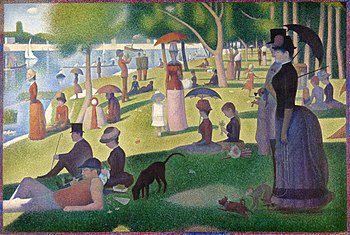 | |
| Artist | Georges Seurat |
| Year | 1884–1886 |
| Medium | Oil on canvass |
| Subject | People relaxing at la Grande Jatte, Paris |
| Dimensions | 207.six cm × 308 cm (81.vii in × 121.25 in) |
| Location | Art Institute of Chicago |
A Sunday Afternoon on the Island of La Grande Jatte (French: Un dimanche après-midi à fifty'Île de la Grande Jatte) was painted from 1884 to 1886 and is Georges Seurat'southward most famous work.[1] A leading example of pointillist technique, executed on a large canvas, it is a founding piece of work of the neo-impressionist movement. Seurat'south composition includes a number of Parisians at a park on the banks of the River Seine. It is in the drove of the Art Institute of Chicago.
Groundwork [edit]
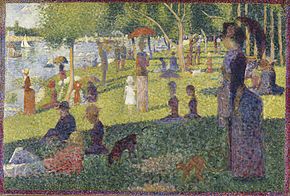
Georges Seurat, Report for "A Sunday Afternoon on La Grande Jatte", 1884, oil on canvass, 70.5 10 104.1 cm, Metropolitan Museum of Fine art, New York
In 1879, Georges Seurat enlisted as a soldier in the French army and arrived dorsum dwelling in 1880. Later, he ran a small painter's studio in Paris, and in 1883 showed his work publicly for the offset time. The post-obit year, Seurat began to work on La Grande Jatte and exhibited the painting in the spring of 1886 with the Impressionists.[two] With La Grande Jatte, Seurat was immediately best-selling as the leader of a new and rebellious class of Impressionism called Neo-Impressionism.[iii]
Seurat painted A Dominicus Afternoon between May 1884 and March 1885, and from October 1885 to May 1886, focusing meticulously on the mural of the park.[4] He reworked the original and completed numerous preliminary drawings and oil sketches. He saturday in the park, creating numerous sketches of the various figures in order to perfect their course. He concentrated on issues of color, light, and class. The painting is approximately ii by three metres (6.vi ft × 9.8 ft) in size.
Inspired past optical effects and perception inherent in the color theories of Michel Eugène Chevreul, Ogden Rood and others, Seurat adapted this scientific inquiry to his painting.[5] Seurat contrasted miniature dots or minor brushstrokes of colors that when unified optically in the homo center were perceived as a unmarried shade or hue. He believed that this grade of painting, called Divisionism at the time (a term he preferred)[6] only at present known as Pointillism, would make the colors more brilliant and powerful than standard brushstrokes. The utilize of dots of nigh uniform size came in the second year of his piece of work on the painting, 1885–86. To make the feel of the painting fifty-fifty more vivid, he surrounded it with a frame of painted dots, which in plow he enclosed with a pure white, wooden frame, which is how the painting is exhibited today at the Art Institute of Chicago.
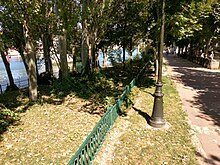
The Island of la Grande Jatte is located at the very gates of Paris, lying in the Seine betwixt Neuilly and Levallois-Perret, a short altitude from where La Défense business commune currently stands. Although for many years it was an industrial site, it is today the site of a public garden and a housing evolution. When Seurat began the painting in 1884, the island was a bucolic retreat far from the urban heart.
The painting was kickoff exhibited at the eighth (and terminal) Impressionist exhibition in May 1886, then in August 1886, dominating the 2d Salon of the Société des Artistes Indépendants, of which Seurat had been a founder in 1884.[1] Seurat was extremely disciplined, always serious, and private to the point of secretiveness—for the nearly part, steering his own steady course. Equally a painter, he wanted to make a difference in the history of art and with La One thousand Jatte, many say that he succeeded.[7]
Estimation [edit]
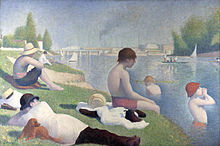
The left bank of working form Bathers at Asnières (1884) mirrors the correct bank of the bourgeoisie on La Grande Jatte.
Seurat's painting was a mirror impression of his own painting, Bathers at Asnières, completed shortly earlier, in 1884. Whereas the bathers in that earlier painting are doused in light, well-nigh every effigy on La Grande Jatte appears to be cast in shadow, either under trees or an umbrella, or from some other person. For Parisians, Sunday was the day to escape the heat of the city and head for the shade of the trees and the cool breezes that came off the river. And at beginning glance, the viewer sees many different people relaxing in a park past the river. On the right, a fashionable couple, the adult female with the sunshade and the human being in his acme hat, are on a stroll. On the left, another adult female who is likewise well dressed extends her fishing pole over the water. At that place is a small human being with the black hat and thin cane looking at the river, and a white dog with a brown head, a woman knitting, a homo playing a trumpet, two soldiers standing at attending as the musician plays, and a woman hunched nether an orange umbrella. Seurat as well painted a man with a piping, a woman under a parasol in a gunkhole filled with rowers, and a couple admiring their infant child.[8]
Some of the characters are doing curious things. The lady on the right side has a monkey on a leash. A lady on the left near the river bank is fishing. The area was known at the fourth dimension as existence a place to procure prostitutes among the bourgeoisie, a likely allusion of the otherwise odd "angling" rod. In the painting's centre stands a piffling girl dressed in white (who is not in a shadow), who stares directly at the viewer of the painting. This may be interpreted every bit someone who is silently questioning the audience: "What will become of these people and their form?" Seurat paints their prospects bleakly, cloaked as they are in shadow and suspicion of sin.[9]
In the 1950s, historian and Marxist philosopher Ernst Bloch drew social and political significance from Seurat'due south La Grande Jatte. The historian'southward focal point was Seurat's mechanical employ of the figures and what their static nature said about French society at the time. Afterwards, the work received heavy criticism past many that centered on the artist'south mathematical and robotic interpretation of modernity in Paris.[8]

According to historian of Modernism William R. Everdell:
Seurat himself told a sympathetic critic, Gustave Kahn, that his model was the Panathenaic procession in the Parthenon frieze. Only Seurat didn't desire to paint aboriginal Athenians. He wanted 'to make the moderns file past ... in their essential form.' Past 'moderns' he meant nothing very complicated. He wanted ordinary people as his subject, and ordinary life. He was a bit of a democrat—a "Communard," equally one of his friends remarked, referring to the left-wing revolutionaries of 1871; and he was fascinated past the mode things distinct and dissimilar encountered each other: the city and the country, the farm and the factory, the bourgeois and the proletarian meeting at their edges in a sort of harmony of opposites.[10]
The border of the painting is, unusually, in inverted color, as if the world around them is also slowly inverting from the manner of life they accept known. Seen in this context, the boy who bathes on the other side of the river banking concern at Asnières appears to be calling out to them, as if to say, "We are the future. Come and join u.s.a.".[ix]
Painting materials [edit]
Seurat painted the La Grande Jatte in three singled-out stages.[xi] In the kickoff phase, which was started in 1884, Seurat mixed his paints from several individual pigments and was still using dull earth pigments such every bit ochre or burnt sienna. In the 2d stage, during 1885 and 1886, Seurat dispensed with the world pigments and too express the number of private pigments in his paints. This alter in Seurat'due south palette was due to his application of the advanced color theories of his time. His intention was to paint modest dots or strokes of pure color that would then mix on the retina of the beholder to achieve the desired color impression instead of the usual practice of mixing private pigments.
Seurat'south palette consisted of the usual pigments of his fourth dimension such every bit cobalt blueish, emerald dark-green and vermilion.[12] [13] Additionally, Seurat used so new pigment zinc xanthous (zinc chromate), predominantly for yellow highlights in the sunlit grass in the middle of the painting only also in mixtures with orange and blue pigments. In the century and more since the painting'south completion, the zinc yellow has darkened to brown—a color degeneration that was already showing in the painting in Seurat'southward lifetime.[14] The discoloration of the originally bright yellow zinc yellow (zinc chromate) to brownish colour is due to the chemical reaction of the chromate ions to orange-colored dichromate ions.[15] In the third stage during 1888–89 Seurat added the colored borders to his composition.
The results of investigation into the discoloration of this painting have been combined with further research into natural aging of paints to digitally rejuvenate the painting.[16]
Acquisition past the Art Institute of Chicago [edit]
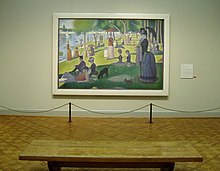
On display at the Fine art Constitute of Chicago
In 1923, Frederic Bartlett was appointed trustee of the Art Establish of Chicago. He and his second married woman, Helen Birch Bartlett, loaned their collection of French Mail-Impressionist and Modernist fine art to the museum. It was Mrs. Bartlett who had an interest in French and avant-garde artists and influenced her husband'due south collecting tastes. Sunday Afternoon on the Island of La Grande Jatte was purchased on the advice of the Art Constitute of Chicago's curatorial staff in 1924.[17]
In conceptual creative person Don Celender's 1974–75 book Ascertainment and Scholarship Test for Fine art Historians, Museum Directors, Artists, Dealers and Collectors, it is claimed that the institute paid $24,000 for the piece of work[17] [18] (over $354,000 in 2018 dollars[19]).
In 1958, the painting was loaned for the only time: to the Museum of Modern Art in New York. On 15 April 1958, a burn there, which killed one person on the second floor of the museum, forced the evacuation of the painting, which had been on a flooring above the fire, to the Whitney Museum, which adjoined MoMA at the time.[20]
In pop culture [edit]

Topiary Park in Columbus, Ohio, replicates much of the painting
The May 1976 issue of Playboy featured Nancy Cameron—Playmate of the Month in January 1974—on its cover, superimposed on the painting in similar manner. The oftentimes hidden bunny logo was bearded as one of the millions of dots.[21]
The painting is the basis for the 1984 Broadway musical Dominicus in the Park with George past Stephen Sondheim and James Lapine, which tells a fictionalized story of the painting's creation. Subsequently, the painting is sometimes referred to by the misnomer "Sunday in the Park".
The painting is prominently featured in the 1986 one-act film Ferris Bueller'due south Day Off, in a scene subsequently parodied, amidst others, in Looney Tunes: Back in Activity, Family Guy, and Muppet Babies.[ citation needed ]
In the Simpsons episode "Mom and Pop Art" (10x19), Barney Gumble offers to pay for a beer with a handmade reproduction of the painting. The painting is also parodied in the picnic scene at the end of the episode "Super Franchise Me" (26x3).
In Topiary Park (formerly Former Deaf School Park) in Columbus, Ohio, sculptor James T. Bricklayer re-created the painting in topiary form; the installation was completed in 1989.[22]
The painting was the inspiration for a commemorative poster printed for the 1993 Detroit Belle Isle Thou Prix, with racing cars and the Detroit skyline added.
In 2011, the cast of the US version of The Function re-created the painting for a poster to promote the show's seventh-flavor finale.[23]
The embrace photo of the June 2014 edition of San Francisco magazine, "The Oakland Issue: Special Edition", features a scene on the shore of Lake Merritt that re-creates the poses of the figures in Seurat's painting.[24]
The painting is featured in the Brute Crossing video game series as a purchasable furniture item under the name the "Calm Painting".
On the 2nd of December 2021, the painting was used equally part of an hommage to Georges Seurat by Google in 1 of its doodles.[25]
[edit]
| External video | |
|---|---|
| |
-
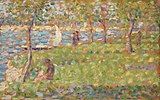
Study for La Thou Jatte
-
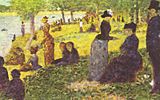
Die Insel La Grande Jatte mit Ausflüglern, 1884
-

Paysage et personnages, 1884–85
-

Groupe de personnages, 1884–85
-

Esquisse d'ensemble, 1884–85
-

Femmes au bord de fifty'eau, 1885–86
-

Models (Les Poseuses) 1886-1888
Meet as well [edit]
- 100 Slap-up Paintings
References [edit]
- ^ a b Seurat, Georges. "A Sunday on La Grande Jatte — 1884". The Art Institute of Chicago . Retrieved 17 May 2021.
- ^ Clayton, S. Hollis (1996). Tomlinson, Janis (ed.). The Family and the Male parent: The 'Thou Jatte' and Its Absences . Readings in Nineteenth-Century Art. Prentice Hall. p. 212-213. ISBN978-0-1310-4142-4.
- ^ Chu, Petra ten-Doesschate (2012). Nineteenth-Century European Art (tertiary ed.). Prentice Hall. pp. 414–417. ISBN978-0-1319-6269-9.
- ^ Dorra, Henri; Rewald, John (1959). Seurat: Fifty'œuvre peint, Biographie et Catalogue Critique (in French). Paris: Les Beaux-Arts. p. 156.
- ^ Herbert, Robert (1968). Neo-Impressionism . New York: Solomon R. Guggenheim Foundation. p. 106.
- ^ Galitz, Kathryn Calley (2007). Masterpieces of European Painting, 1800–1920, in the Metropolitan Museum of Art. New York: Metropolitan Museum of Art. p. 177. ISBN978-1-58839-240-4.
- ^ Herbert, Robert L.; Neil Harris; Georges Seurat (2004). Seurat and the making of 'La Grande Jatte . Chicago: Fine art Establish of Chicago in association with the University of California Press. ISBN978-0-5202-4210-four.
- ^ a b Burleigh, Robert (2004). Seurat and La Grande Jatte: connecting the dots . New York: Harry Due north. Abrams. ISBN978-0-8109-4811-2 . Retrieved 27 November 2021.
- ^ a b "Georges Seurat: A Sunday Afternoon on the Island of La Grande Jatte". The Private Life of a Masterpiece. Series four. 2005. BBC Ii.
- ^ Everdell, William R. (1997). The First Moderns: The Offset Moderns: Profiles in the Origins of Twentieth Century Idea. Chicago: Academy of Chicago Printing. p. 67. ISBN978-0-2262-2481-seven . Retrieved 27 November 2021.
- ^ Fiedler, Inge (2004). La Grande Jatte: A Study of the Painting Materials. Seurat and the Making of La Grande Jatte. University of California. pp. 110–113.
- ^ Fiedler, Inge (1989). "A Technical Evaluation of the 'Grande Jatte'". Art Institute of Chicago Museum Studies. 14 (2): 173–179, 244–245. doi:10.2307/4108750. JSTOR 4108750.
- ^ "Georges Seurat, 'Sunday afternoon on La Grande Jatte'". ColourLex.
- ^ Gage, John (1993). Color and Culture: Practice and Significant from Antiquity to Abstraction. Boston: Little, Dark-brown. pp. 220, 224. ISBN978-0-5202-2225-0.
- ^ Casadio, Francesca; Fiedler, Inge; Grayness, Kimberly A.; Warta, Richard (2008). Bridgland, Janet (ed.). "Deterioration of zinc potassium chromate pigments: elucidating the effects of paint composition and environmental conditions on chromatic alteration". 15th Triennial Conference Preprints, New Delhi, 22–26 September 2008. Paris: International Council of Museums: 572–580. ISBN9788184243468.
- ^ Berns, Roy Due south. (2006). "Rejuvenating the color palette of Georges Seurat's A Sun on La Grande Jatte—1884: A simulation". Color Research & Application. 31 (4): 278–293. doi:10.1002/col.20223.
- ^ a b "The Art Constitute of Chicago, A Lord's day on La Grande Jatte, 1884". Archived from the original on twenty September 2016. Retrieved x May 2012.
- ^ Celender, Don (1974–75). Ascertainment and Scholarship Test for Art Historians, Museum Directors, Artists, Dealers, and Collectors. Publication was produced for an exhibition held at the O.Yard. Harris Gallery, 383 Due west Broadway, New York, from 7 to 28 December 1974. pp. Question: Page 5, Reply: Page 23.
- ^ "CPI Aggrandizement Calculator". Archived from the original on 4 August 2016. Retrieved three Nov 2013.
- ^ Kihss, Peter (16 April 1958). "Fire in Modern Museum; Almost Fine art Safe; 6 Canvases Burned, Seurat's Removed". The New York Times. p. ane.
- ^ "Stagerism Alarm: Seurat". Lucass Pivey. 7 March 2010. Archived from the original on 28 June 2013. Retrieved 27 November 2021.
- ^ "The Topiary Park: A Unique Interpretation of a Painting". The Topiary Park. Archived from the original on 20 October 2013.
- ^ Hibbert, James (16 May 2011). "Starting time Look: NBC's amazing new 'The Function' poster". Entertainment Weekly. Archived from the original on 26 October 2015. Retrieved 27 Nov 2021.
- ^ "The Oakland Issue". San Francisco. June 2014. Archived from the original on 26 February 2015. Retrieved 26 Feb 2015.
- ^ "Google rend hommage ce jeudi à ce maître de la peinture : qui était Georges Seurat". Sud Ouest. December 2021.
- ^ "Seurat, A Sunday on La Grande Jatte". Smarthistory at Khan Academy . Retrieved 23 April 2016.
Further reading [edit]
- Herbert, Robert L.; Robert Herbert; Georges Seurat; Gary Tinterow; Françoise Cachin; Anne Distel; Susan Alyson Stein (1991). O'Neill, J (ed.). Georges Seurat, 1859–1891. New York: The Metropolitan Museum of Art. ISBN978-0-8109-6410-5.
- William R. Everdell, The First Moderns: Profiles in the Origins of Twentieth Century Thought (Chicago: University of Chicago Printing).
- "Firey Peril in a Showcase of Modernistic Art". Life. 28 April 1958. pp. 53–55.
External links [edit]
- Seurat and the Making of La Grande Jatte
- La Grande Jatte – Inspiration, Assay and Critical Reception
- A Sunday on La Grande Jatte — 1884 at The Art Institute of Chicago
- Georges Seurat, 1859–1891, MoMA exhibition catalog
- Georges Seurat, Sunday Afternoon at La Grande Jatte, ColourLex
- Roch, Christine 50. "From "Rube Boondocks" to Modern Urban center". Archived from the original on 15 Oct 2012. Retrieved 4 August 2011.
Source: https://en.wikipedia.org/wiki/A_Sunday_Afternoon_on_the_Island_of_La_Grande_Jatte
0 Response to "Where in the Art Institute Is Sunday Afternoon on the Island of La Grande Jatte"
ارسال یک نظر